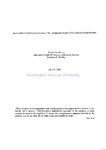Inaccessible Unemployment Insurance: The Unsupported Reality of Low-Income Single Mothers

View/
Author
Mazza, Mary Carol
Subject
Washington and Lee University, Shepherd Poverty Program
Poverty
Low-income single mothers
Unemployment insurance
Sex discrimination against women
Part-time employment
Child care
Metadata
Show full item recordDescription
Mary Carol Mazza is a member of the Class of 2003 of Washington and Lee University. Capstone; [FULL-TEXT FREELY AVAILABLE ONLINE] In 1998, single mother headed 25 percent of all families with children in the United States. In the six year span between 1993 and 1999, the families maintained by working single mothers jumped from 6.4 to 7.6 million, rising by close to 20 percent (Alstott, 2001). In line with these figures, the Census Bureau predicts over the next decade an increase in the percentage of mother-supported households and a decrease in married couple households (Census Bureau, 1996). While the number of single-mother families rises, their financial stability appears to be one area that might draw further attention. Despite nearly an 80 percent labor force participation rate, the median income of single mothers in 1998 stood at a mere $22,000. Not surprisingly, in that year close to 40 percent of all single-mother families were classified as poor, with further analyses showing a rising poverty gap within the group (Alstott, 2001). With so many mothers working and with the much touted government benefit system to serve as a safety net, what could be an explanation for this poverty? [From Introduction] Mary Carol Mazza